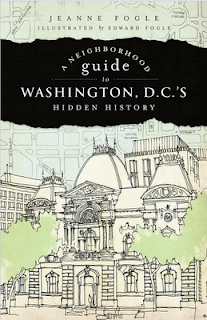The First in a Series Covering Recent and Classic Publications on the Humanities in DC
The inaugural review for this series was written by Humanities Council intern, and graduate student in Public History, Bridget Sullivan. Sullivan will enter the second year of in the Public History Master's Degree Program at American University this Fall. She has worked extensively this Summer as a liaison to the Humanities Council's DC Community Heritage Project grantees, and on other projects related to District history and culture.
Jeanne Fogle provides a comprehensive stop-by-stop guide to the major neighborhoods of Washington, DC in her work A Neighborhood Guide to Washington, D.C.’s Hidden History. Each chapter details the gems of history hidden inside the architectural landscape of the city. Ten to fifteen locations in each neighborhood represent the evolution and history of that area. Together, they provide a picture of the multifaceted history of the nation’s capital.
Fogle’s book functions as a self-guided tour through some of the oldest neighborhoods in Washington, DC. The variety of sites makes this a good read for both newcomers to the city and Washingtonians alike. For newcomers, it gives a good introduction to the history of the city. Doing any one of these tours will leave the participants with an understanding of the neighborhood’s history and place in the DC community. On the other hand, the breadth of sites discussed is guaranteed to provide some new discoveries for those who have known the city for a number of years. Fogle excels at highlighting the history of buildings that most pass by without a second glance.
One of the most interesting parts of the book is the fusion of social and architectural history. Fogle blends the two areas together to provide a comprehensive overview each location. She weaves together a variety of locations across the spectrum of historical significance. This variety ensures that there is something in each tour to engage the interest of all participants.
Overall, Fogle’s guide is perfect as both an introduction to the city or as a resource for continued study. She successfully identifies some of the best historic gems in our nation’s capitol and provides a concise description of their historical significance. One of the many strengths of this book is the ability to create an individualized tour. The organization of the book allows easy planning. Further, the accompanying illustrations are both artistic and a resource for tour takers. A Neighborhood Guide to Washington, DC’s Hidden History is a must for city explorers.
Fogle's work sounds like a great accompanying text for Cultural Tourism DC's extraordinary series of self-guided walking tours, and a must-own introductory text for Washingtonians interested in connecting with their community's past.


No comments:
Post a Comment